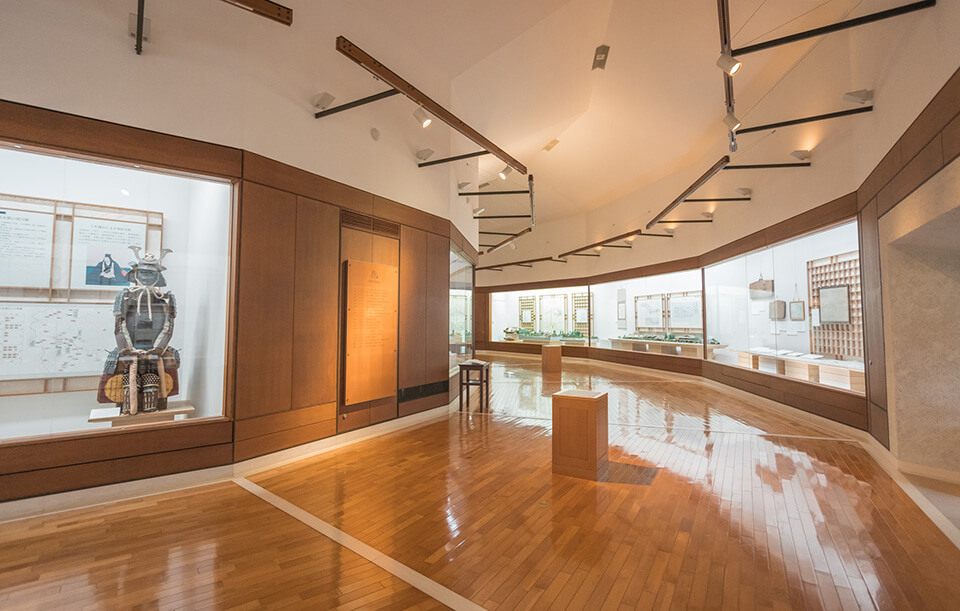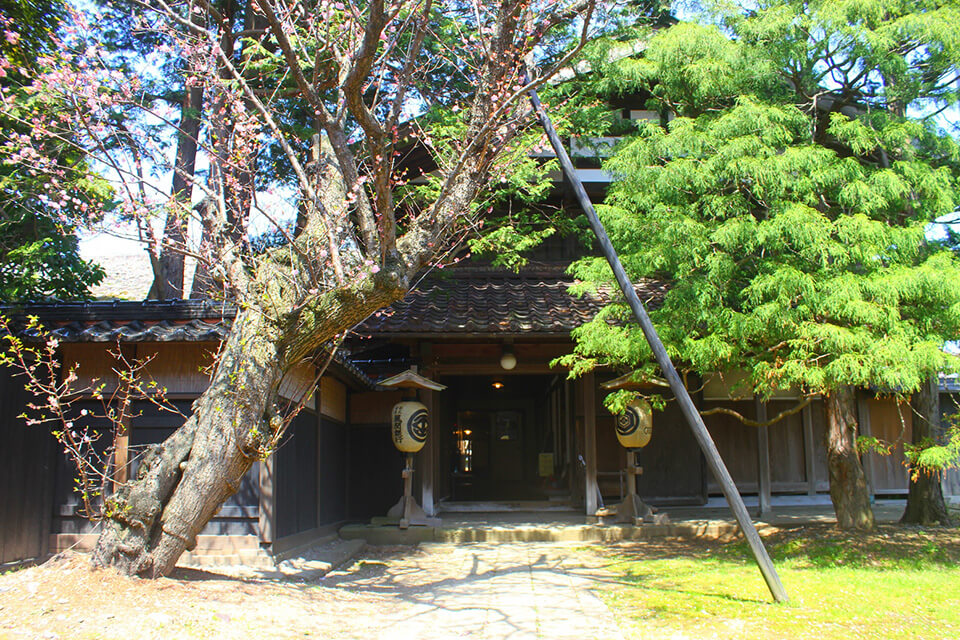This three day trip takes you to Sekikawa, which prospered as an inn town along the old Yonezawa Highway, the port city Sakata, which is full of Kitamaebune trade ship culture, and Tsuruoka, the castle town of the Shonai Domain. You’ll visit historic places such as the wealthy merchant Watanabe Residence, “Somaro”, where you can experience old Kyoto today, Abumiya, which is the film location of the television movie “Oshin”, and the Chido museum.
Itinerary
nights
days
Day One
01
Watanabe Residence
In the Edo period, Sekikawa was an inn town along the bustling Yonezawa Highway. There are still many buildings standing that show how life was lived back then and make it feel like you just stepped out of a time machine. The Watanabe residence is a wealthy merchant’s house built in 1817 and is a Nationally-designated Important Tangible Cultural Property.


The large property has a thatched roof main wing and six separate earthen storehouses. You can enjoy a beautiful view of the award-winning garden from the large tatami room inside.
Address: 904 Shimoseki, Sekikawa, Iwafune-gun, Niigata 959-3265
Access: 5 minute walk from Echigo-Shimoseki Station
Entry fee: 600 yen for adults, 250 yen for elementary students (free for kids under school age)
02
Toukeien
Toukeien, a branch of the Watanabe Residence, was built in 1905. The two-story wooden structure features tiled roofing that uses structural technology still being used today. The building is connected to the Watanabe Residence, so visit both while you’re there.


You can also have lunch while viewing the property’s garden (reservations required). There are 1,500 yen and 2,500 yen lunch courses.
Open: Mid-April-Early November
Open hours: 9:00-16:00
Admission fee: Adults: 100 yen, Elementary students: 50 yen
Click here for lunch reservations
03
Sekikawa History and Road Museum
Inside this museum are historical Sekikawa and Watanabe Residence documents and exhibitions, as well as a model recreation of the former 18th century Yonezawa Highway. There’s also a corner where you can try on a set of 15 kg samurai armor.
Open hours: 9:00-16:30
Closed: Mondays, New Year’s
Admission fee: Adults: 300 yen, Students: 150 yen


04
Echigo Sekikawa Hot Spring Town
This hot spring town runs along the Arakawa river and includes five different locations: Takanosu Kan, Takase Hot Spring, Kira Hot Spring, Yuzawa Hot Spring, and Katsura no Seki Hot Spring. The natural scenery throughout the year makes the location especially appealing. You can also enjoy local cuisine made with local plants, mushrooms, and river fish.
Day Two
01
Hiyoriyama Park
In Sakata, you can find Japanese heritage history revolving around the Kitamaebune ship culture everywhere you look. It’s believed that sailors of the Kitamaebune ships used to stand on top of Hiyoriyama’s hill to check the weather before departing. You can find a 1:2 scale model of a Kitamaebune ship, Japan’s oldest wooden hexagon lighthouse, and a stone compass in the park.


Hiyoriyama Park is also a popular spot for viewing cherry blossoms. The Sakata Hiyoriyama Park Cherry Blossom Festival is held every year in April.
Japan Heritage URL: Click here for details
Address: 1 Chome-10 Minamishinmachi, Sakata, Yamagata 998-0063
Access: Approximately 6 minute drive from Sakata Station
5 minutes by Shonai Kotsu bus from Sakata Station (get off at Kotobukicho)
5 minute walk from Sakata Station
02
Somaro
This tea house was originally a traditional Japanese restaurant named Somaya and visited by Kitamaebune shipowners and merchants and is a designated national cultural asset. On the first floor is the “Sabo Kutsurogi Tokoro” teahouse, and on the second floor is the large banquet hall used as a theater where you can enjoy Maiko performances and food (lunch is reservation only). Maiko performances are every afternoon at 2:00 in the banquet hall. In the storehouse you can find Hina Doll and Yumeji Takehisa woodblock print and photo galleries.
URL Click here for details
Open hours: 10:00-17:00
(Maiko performances at 2:00)
Fee: (Performance ticket) Adults: 1,800 yen, Students: 1,000 yen, Elementary students and under: Free
Closed: Wednesdays, Obon season, and New Year’s


03
Honma Residence
This historical location is the home of the Honma family, who became wealthy merchants through Kitamaebune trading. Built by the third lord of Honma family, Mitsuoka Honma, in the middle of the 18th century, originally this gated residence was intended to serve as quarters for the Shogun’s officials sent to Sakata. It later became the Honma family’s place of residence. The building’s samurai residence and merchant structural style are rare even in Japan. It’s said that the merchant structure building was used for everyday life, and the samurai building was only used for special occasions.
URL Click here for details
Admission fee: Adults: 700 yen, Middle and high school students: 300 yen, Elementary students: 200 yen
Open hours: March-October 9:30-16:30, November-February 9:30-16:00
Closed: Mid-December to Late January, Days when changing exhibitions (indeterminate)
04
Abumiya
Abumiya is a shop and residence that flourished throughout the Edo period through the Kitamaebune trades. Abumiya played a large role in the prosperity of the Sea of Japan, and was even introduced in a poem by Ihara Saikaku. The current building is a reconstruction of the 1845 original and is designated as a historical landmark. The building’s architecture is a typical town house, and the inside gives you a glimpse of what the time period was like. It was also the filming location of the movie, “Oshin”.
URL Click here for details
Open: 9:00-16:30
Closed: December-February: every Monday(Open on National Holidays but closed the following day)
New Year’s (December 29-January 3)
March-November: open every day
Admission fee: Adults: 320 yen, High school and college students: 210 yen, Elementary students: 100 yen

Day Three
01
Chido Museum
Formerly part of the Tsurugaoka Castle estate, Lord Sakai of the Shonai Domain’s residence is open to the public as a museum. Included at the museum are the nationally designated cultural property Former Nishitagawa District Office, a traditional house, the Former Tsuruoka Police Office, and other historical and valuable buildings. There’s also a rare traditional Japanese garden and a storage house exhibiting 5,350 historical documents.
URL Click here for details
Address: 10-18 Kachushinmachi, Tsuruoka, Yamagata 997-0036
Admission fee: 700 yen, Students: 380 yen, Elementary students: 280 yen
Open hours: 9:00-17:50 (admission is until 16:30)
*December-February hours are 9:00-16:30 (admission is until 16:00)
Closed: New Year’s (December 28-January 4)
Every Wednesday between December-February
Access: 10 minute drive from Tsuruoka Station.
10 minute bus ride on Tsuruoka Station Bus towards Yunohama Hot Spring (get off at Chido Museum)


02
Heishindo
The Kazama family was one of the wealthiest merchants in Tsuruoka. In 1896, the seventh head of the Kazama family, Koemon, built and used Heishindo as a place of residence and business. The building has been chosen as a Nationally-designated Important Tangible Cultural Property.
Featuring the main building and four surrounding warehouses and black pillars, the property gives you a look into the life of a merchant. Heishindo’s small tatami room was used in the filming of the movie, “The Samurai I Loved.
Address: 1-17 Babacho, Tsuruoka, Yamagata 997-0035
Hours: 9:30-16:30 (final admissions at 16:00)
Closed: July 13th (for Obon season), December 1st-April 9th (During the Tsuruoka Hina Monogatari event(March), special areas of the property will be open)
Admission fee: 400 yen, Elementary students: 200 yen
